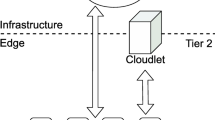Abstract
We propose a new elastic application model that enables seamless and transparent use of cloud resources to augment the capability of resource-constrained mobile devices. The salient features of this model include the partition of a single application into multiple components called weblets, and a dynamic adaptation of weblet execution configuration. While a weblet can be platform independent (e.g., Java or .Net bytecode or Python script) or platform dependent (native code), its execution location is transparent—it can be run on a mobile device or migrated to the cloud, i.e., run on one or more nodes offered by an IaaS provider. Thus, an elastic application can augment the capabilities of a mobile device including computation power, storage, and network bandwidth, with the light of dynamic execution configuration according to device’s status including CPU load, memory, battery level, network connection quality, and user preferences. This paper presents the motivation behind developing elastic applications and their architecture including typical elasticity patterns and cost models that are applied to determine the elasticity patterns. We implement a reference architecture and develop a set of elastic applications to validate the augmentation capabilities for smartphone devices. We demonstrate promising results of the proposed application model using data collected from one of our example elastic applications.















Similar content being viewed by others
References
Amazon EC2. http://aws.amazon.com/ec2/. Accessed 21 Mar 2011
RFMD product data sheet. http://www.rfmd.com/products. Accessed 21 Mar 2011
Wifi power consumption analysis. http://nesl.ee.ucla.edu/fw/documents/reports/2007/poweranalysis.pdf. Accessed 21 Mar 2011
Samsung flash memory databook. http://www.samsung.com/global/business/semiconductor/packageInfoList.do. Accessed 21 Mar 2011
Analog devices data sheet. http://www.analog.com/en/content/psearch_landing/fca.html. Accessed 21 Mar 2011
Armbrust M, Fox A, Griffith R, Joseph AD, Katz RH, Konwinski A, Lee G, Patterson DA, Rabkin A, Stoica I, Zaharia M (2009) Above the clouds: a berkeley view of cloud computing. Technical Report UCB/EECS-2009-28. EECS Department, University of California, Berkeley
Balan R, Flinn J, Satyanarayanan M, Sinnamohideen S, Yang H (2002) The case for cyber foraging. In: Proc. of the 10th ACM SIGOPS European workshop
Balan RK, Satyanarayanan M, Park S, Okoshi T (2003) Tactics-based remote execution for mobile computing. In: Proc. of the 1st international conference on mobile systems, applications, and services, pp 273–286
Chun B-G, Maniatis P (2009) Augmented smartphone applications through clone cloud execution. In: USENIX HotOS XII
Flinn J, Park S, Satyanarayanan M (2002) Balancing performance, energy, and quality in pervasive computing. In: Proc. of the international conference on distributed computing systems
Gu X, Messer A, Greenberg I, Milojicic D, Nahrstedt K (2004) Adaptive offloading for pervasive computing. IEEE Pervasive Computing 3(3):66–73
Gu X, Nahrstedt K, Messer A, Greenberg I, Milojicic D (2003) Adaptive offloading inference for delivering applications in pervasive computing environments. In: Proc. of IEEE international conference on pervasive computing and communications
Gurun S, Krintz C, Wolski R (2004) Nwslite: a light-weight prediction utility for mobile devices. In: Proc. of international conference on mobile systems, applications, and services
Hunt GC, Scott ML, Hunt GC, Scott ML (1999) The coign automatic distributed partitioning system. In: Proc. of the 3rd symposium on operating systems design and implementation, pp 187–200
Kondo D, Javadi B, Malecot P, Cappello F, Anderson DP (2009) Cost-benefit analysis of cloud computing versus desktop grids. in: proc. of the ieee international symposium on parallel & distributed processing
Li X, Li Y, Liu T, Qiu J, Wang F (2009) The method and tool of cost analysis for cloud computing. In: Proc. of IEEE international conference on cloud computing
Poladian V, Sousa JP, Garlan D, Shaw M (2004) Dynamic configuration of resource-aware services. In: Proc. of international conference on software engineering
Porras ORJ, Kristensen MD (2008) Dynamic resource management and cyber foraging. Chapter Middleware for Network Eccentric and Mobile Applications. Springer Press
Kozuch M, Satyanarayanan M (2002) Internet suspend/resume. In: Proc. of the 4th IEEE workshop on mobile computing systems and applications
Narayanan D, Flinn J, Satyanarayanan M (2000) Using history to improve mobile application adaptation. In: Proc. of the 3rd IEEE workshop on mobile computing systems and applications
Rellermeyer JS, Alonso G, Roscoe T (2007) R-osgi: distributed applications through software modularization. In: Proc. of the ACM/IFIP/USENIX international conference on middleware
Santos N, Gummadi KP, Rodrigues R (2009) Towards trusted cloud computing. In: Proc. of the workshop on hot topics in cloud computing
Satyanarayanan M, Bahl P, Caceres R, Davies N (2009) The case for vm-based cloudlets in mobile computing. IEEE Pervasive Computing 8(4):14–23
Sousa JP, Balan RK, Poladian V, Garlan D, Satyanarayanan M (2008) User guidance of resource-adaptive systems. In: Proc. of international conference on software and data technologies
Sousa J, Garlan D (2002) Aura: an architectural framework for user mobility in ubiquitous computing environments. In: Proc. of the 3rd Working IEEE/IFIP conference on software architecture
Travostino F (2006) Seamless live migration of virtual machines over the man/wan. In: Proc. of the ACM/IEEE conference on Supercomputing
Vijaykrishnan N, Kandemir M, Irwin M, Kim H, Ye W (2000) Energy-driven integrated hardware-software optimizations using simplepower. In: Proc. of the int. symposium on computer architecture
Walker E (2009) The real cost of a CPU hour. IEEE Comput 42(4):35–41
Xian C, Lu YH, Li Z (2007) Adaptive computation offloading for energy conservation on battery-powered systems. In: ICPADS
Zhang H, Jiang G, Yoshihira K, Chen H, Saxena A (2009) Intelligent workload factoring for a hybrid Cloud computing model. In: Proc. of the congress on services
Zhang X, Schiffman J, Gibbs S, Kunjithapatham A, Jeong S (2009) Securing elastic applications on mobile devices for cloud computing. In: Proc. of ACM cloud computing security workshop
Zhao G, Shen Z, Miao C, Wan C (2009) ELM-based intelligent resource selection for Grid scheduling. In: Proc. of IEEE international conference on machine learning and applilcations
Author information
Authors and Affiliations
Corresponding author
Rights and permissions
About this article
Cite this article
Zhang, X., Kunjithapatham, A., Jeong, S. et al. Towards an Elastic Application Model for Augmenting the Computing Capabilities of Mobile Devices with Cloud Computing. Mobile Netw Appl 16, 270–284 (2011). https://doi.org/10.1007/s11036-011-0305-7
Published:
Issue Date:
DOI: https://doi.org/10.1007/s11036-011-0305-7




